Why Crate Training Is Beneficial
Ever feel like a bad pet parent for leaving your canine companion in their crate while you’re out of the house for a few hours? Well, don’t! It’s far from cruel. Turns out that crate training is beneficial in a number of ways. If your dog could talk, they’d say “Thank you for giving me a comfortable and cozy place to snooze, woof!”.
Is it Humane to Crate Train?
Yes, crate training is regarded as a healthy experience for puppies. Top pet specialists like veterinarians, dog handlers, and breeders are advocates of using crates as positive reinforcement and as a way to make your pet feel safe and secure. DIGGS believes that every pup can benefit from a safe and comfortable carting experience, and we even offer our own Virtual Training Sessions. The key is to introduce the crate as a happy and rewarding place, and the rest should flow relatively smoothly.
For the most consistent training regimen, you may want to try a versatile travel crate solution. Adaptable, safe and portable, the Revol Crate System and Evolv Dog Crate allow your pup to lounge at home with open walls or enjoy the safety of a spacious haven when on the go.
Read on to discover all of the ways that crate training is, in fact, healthy for your furry friend. Included below as well are some tips and tricks on how to properly crate train your canine companion.
What’s the Difference Between a Crate and a Kennel?
A dog crate is typically a collapsible pen that could be made up of a variety of materials like plastic, fabric, or metal. It’s a small, safe, and well-confined space that’s used in the home or to transport a pet while traveling. It’s large enough for a dog to stand up and turn around in.
A good crate doesn’t make a pup feel scrunched but gives them just enough room to move around. Additionally, a good quality crate is easy to set up and transport and all-around comfortable for both the pet and the pet parent. Extra points if it’s aesthetically pleasing and adds flair to your home or vehicle.
A kennel on the other hand comes in one of two varieties. The first is a travel-safe solution that stows easily in the cargo hold of an SUV. Inflatable versions, like the Enventur Travel Kennel, are designed for protection and comfort. The alternative definition of kennel refers to a large outdoor pen, like those used to house hunting breeds.
How to Make Your Dog Feel Safe in a Crate
First and foremost, if you treat your dog’s crate as a safe haven, it will become just that. A crate is a pleasant place for snoozing, lounging, people watching, and for your pup to enjoy their chews in peace.
Your dog will appreciate their little home within a home. It’s not supposed to be imprisonment of any kind, or hold any sort of negative connotation. It’s safe and secure, a personal place that has the potential to calm anxiety (which will then calm yours) and get your dog into a happy mindset. A comfy crate is an effective crate, especially if it’s clad with a crate training tool that’s designed to teach your pet to love their space.
Pet parent peace of mind is incredibly beneficial for a happy and healthy Fido too. While we’d all like to spend every waking moment with our furry friends (right?), that’s just not realistic. There will be times that we have to leave the house and leave our pet behind.
Pet peace of mind is important too! And the crate will assist with that. The crate has the capacity to give your dog a mental break, especially if it’s in an overwhelming space (your children are out and about, you have people over dinner, so on and so forth). After being crate trained, many dogs will voluntarily excuse themselves and go into their crate for relaxation, downtime, and to get away from the hustle and bustle of the moment.
Can You Potty Train with a Crate?
Yes, crating dogs from a young age is a great way to potty train them. Crate training is an essential part of housebreaking puppies, as dogs don’t like to soil the place that they sleep. They’re innately clean animals, and generally do not want to go to the bathroom in the snug space that is their crate.
The trick is to choose a crate that is the right size for your dog. One that is too large will give your pet the false idea that a portion of the space is for elimination, while the rest is for lounging. As mentioned previously, make sure the crate is just big enough for your dog to stand up and turn around in.
Does Your Dog Feel Safe in a Crate?
Pet parent peace of mind is incredibly beneficial for a happy and healthy Fido. While we’d all like to spend every waking moment with our furry friends (right?), that’s just not realistic. There will be times that we have to leave the house and leave our pet behind.
Knowing your buddy is in a secure spot while you’re gone will give you a sense of relief as you go about your day. Not only that but crating your dog will keep them from getting into the parts of your home that didn’t extend an invitation.
Pet peace of mind is important too! And the crate will assist with that. The crate has the capacity to give your dog a mental break, especially if it’s in an overwhelming space (your children are out and about, you have people over dinner, so on and so forth). After being crate trained, many dogs will voluntarily excuse themselves and go into their crate for relaxation, downtime, and to get away from the hustle and bustle of the moment.
Can a Crate Help Establish a Routine?
The simplicity of having a routine in your household via the dog crate is another benefit of crate training. An established routine and doing away with unpredictability are proven to elevate a dog’s life experience. In fact, dogs like predictability and routine, especially when it comes to their basic needs of food, shelter, and safety.
Organize a crate training schedule for you and your pup that’s tailored to your lifestyle. Something along the lines of a “potty-play-crate” routine in the morning, afternoon, and evening. In addition, get your dog used to being in their crate throughout the night. You’ll sleep better and so will they.
Household Safety: Preventing Mischief
Crate training prevents your dog from getting into trouble. Needless to say, if your pup is in a crate while you’re gone, they can’t get into outlets, loose hanging wires, furniture, plants, or other tempting items that are lying around.
It’s an important tool in preventing dogs from chewing on things in the home or during housebreaking. Let’s just call crate training a...temptation barrier.
Keeps Your Dog Calm When Traveling
Traveling is stressful enough for a pet and for the pet parent just as much. Crate training alleviates much of this stress by giving the dog a secure place to be while you’re on the go. Whether it’s for a quick ride across town, or to haul them cross country, the crate will ease your dog’s mind. You may notice that their whining and whimpering subsides while they are in their crate.
It’s also important to consider that accidents do occasionally happen. While we hope that all travels are safe travels, that’s not always the case. Your pet’s more likely to survive an accident if they are securely placed in a travel kennel during transit. For maximum safety and comfort, inflatable kennels with tie-downs like The Enventur Travel Kennel, have been crash tested to ensure your pup has the best chances of surviving a serious accident.
How to Crate Train Your Dog
It’s mentioned above that crate training could take up to six months or longer. As always, patience and consistency are vital to the process of crate training.
- Ease your dog into it: Introduce your dog to the crate as soon as you welcome them into your home. Maybe set it up in a place where you spend the most time, and dress it up with a blanket or pad. The crate should always be a positive space, so keep your energy in mind when you’re in close proximity to it.
- Reinforce with Treats: Leaving small treats nearby or inside the crate will encourage your pet and teach them that the crate is a pleasant place to be. Toys and chews work too. If your dog is skeptical at first, don’t force it. In due time, your pet will warm up to their little home. When they do eventually enter, praise them and give them a treat.
- Start with Short Stays: Crate your dog for short periods of time to get them used to the space. Call them into the crate, praise, give a treat, and sit quietly next to them for a couple of minutes. Once that’s complete, move into a nearby room where you’re out of sight. Let them sit with that for a few moments before returning and letting them out. Do this several times throughout the week.
- Make the Crate a Sleep Haven: Crating your dog at night will also teach them that it’s a place of serenity, peace, and rest.
Just a Heads Up
Keep in mind that while crate training is beneficial, it’s not always easy. Nothing good comes easy at first! You may experience whining, whimpering, barking, and separation anxiety when starting the process of crate training. This doesn’t mean that it’s not effective, it just means that your dog is getting the hang of their home within a home.
It’s important to note that having a crate-trained dog won’t solve the problem of separation anxiety. Separation anxiety can only really be solved via counterconditioning and desensitization practices. Consult a veterinarian if you’re running into issues like this.
Summary
Thus, crate training is beneficial in a number of ways. It will make your dog feel safe and secure, assist with house training, give you and your pet some peace of mind, prevent them from getting into dangerous household items, and will facilitate the process of traveling.
Not only that, but it will help create a smooth flowing routine for you and your pet. Keep in mind that dogs should only be crated minimally, as they are social animals that should not be locked up full-time.
Sources:
Crate Training Benefits: Why A Crate Is Great For You And Your Dog | American Kennel Club
Potty Training a Puppy: How to House Train Puppies | American Kennel Club
The Benefits of Crate Training | Paws
Crate training 101| Humane Society
Crate Training: The Benefits for You and Your Dog | SPCA
4 Reasons Your Dog Needs a Routine | Pet Coach
You might also like
Crate training tips, stories and inspiration
View all blogsIn Your Diggs
Share your photos with #DiggsPet and tag us @DiggsPet on IG and TikTok.



